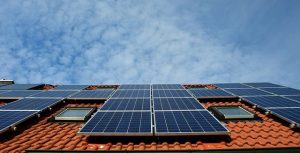
Could a solar photovoltaic system be beneficial to your home?
We have multiple sources of energy for our homes today. While the grid is the typical way of getting our electrical power, other systems such as geothermal and solar photovoltaic offer great savings long-term. Could a solar photovoltaic system be a smart investment for your home? Here are the basics, the types, the pros, and the cons of this technology.
Solar Photovoltaic System Basics
One can likely identify a solar photovoltaic system by its solar panels. Indeed, other names for it are the recognizable solar power system or solar PV system. Plenty of Maryland homeowners have adopted this technology. How does it work, exactly?
Each solar panel consists of numerous PV devices, or cells, that link together to form a module. When several modules connect, it forms an array. Each array sits on a roof or ground mount that directs it to the sun. Within each cell is a semiconducting material that transforms the photons of sunlight into energy. This energy goes through an inverter, which converts the DC electricity into AC for all of our home electricity needs like lighting, appliances, and digital devices. The system also includes a battery, which can store unused solar power and stabilize power transfer. Homes with solar panels often still connect to the grid, so that in peak times, they can still get the ample amount of power they need.
Types of Solar Photovoltaic Cells
The several types of solar photovoltaic technology include thin-film, silicon, III-V, and next-generation solar cells. These different materials all conduct sunlight into DC electricity. Most of today’s solar panels contain silicon solar cells, ideal for larger applications. On the other hand, thin-film is best for portable or more delicate applications like flashlights or windows. III-V, named after its ingredients from Group III and Group V of the periodic table, supplies industrial equipment like satellites. This version is much more expensive and very efficient. Meanwhile, next-generation solar cells are in development, using organic matter and quantum dots.
Pros and Cons
Practically speaking, what can homeowners look forward to with solar photovoltaic systems? They will certainly save you on electricity bills. The cost of solar power systems has declined significantly over the years, you can get a tax credit for it, and you’ll get free electricity. Maintenance is next to nothing. The system will not get in the way of life, as they are silent and passive. On the other hand, you will need additional insurance coverage for it, and you might find some systems to be more efficient.
BUILD YOUR WATERFRONT DREAM HOME WITH SHORE-LINE CONSTRUCTION!
At Shore-Line Construction, we know that your home is a reflection of you. That’s why we strive to make each home we build as beautiful as the family who will live there. We work with each of our clients to design a home that fits their needs. The end result is a durable, energy-efficient custom home that the family will enjoy for generations to come. Shore-Line Construction has been serving our customers for over 25 years, and we look forward to the opportunity to help you!
If you’re interested in learning more about what Shore-Line Construction can do for you, check out our website or give us a call at 410-574-6623. Keep up with all of the latest news by following our blog and social media pages on Facebook, YouTube, Pinterest, and Houzz!



